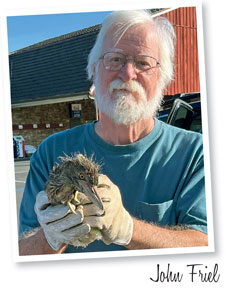3/1/2024
Peeling the Onion
John Friel

We live in a multi-layered world. We’ve known this for many years, but the number and scope of the layers keep expanding.
Starting at the top and descending: Whole aerial ecosystems—plants, insects, animals and, yes, soil—exist in tree canopies. High overhead in Washington’s Hoh rainforest is a biome whose inhabitants never descend to earth. Decomposing vegetable matter, mostly mosses, form a de facto soil into which the trees whose limbs support it often sink aerial roots. The Amazon offers more extreme examples on four tiers: forest floor, understory, canopy, emergent layer.
Down below, we’ve scratched the surface of our habitat, Earth’s crust, and have reached some conclusions about the underlying molten mantle, which sometimes reveals itself in spectacular, terrifying ways. Think Iceland or Mount St. Helens.
In the Grand Canyon, I shared a raft with a geologist. Day after day we rowed between walls as old as time, built layer by layer. Beside us, polished by the flowing Colorado, was unfathomably ancient, jet-black Vishnu schist, shot through with veins of glittering pink Zoroaster granite. From that foundation, successive strata led the eye upward to relatively young Kaibab limestone at the top, a mere 250 million years old. Gesturing at the surrounding cliffs, boulders, scree and endless side canyons my boatmate observed, casually, “All this is just the light fluffy stuff that’s floated to the top.”
Gardens can also have layers, as old friend David Culp explains in his lovely book, “The Layered Garden,” lavishly illustrated with dazzling photography by another old friend, Rob Cardillo. David uses the term “layered” as “shorthand for a design process ... to maximize the beauty and interest of each planted space.” By his definition, plants that flower together are a layer; a section of garden, large or small, can be a layer; and naturally plants that reach, and flower at, different heights constitute layers as well. In other words, it goes beyond mere flowering succession.
Still descending: Unless you’re patronizing a florist in a subway station, flowers are not something you expect to find underground. But that’s exactly what botanists “discovered” in Borneo: A palm that opens its blooms below the surface.
If this were April, you might snort, “Hah! Good one!” But it’s March and no fooling: Pinanga subterranea looks quite unremarkable, but its flowers and fruits are out of sight. There are quotation marks around “discovered” because—surprise!—indigenous people have known about, and eaten, Pinanga for generations.
Scientists call this “geoflory.” No one can explain it fully or answer these questions:
What environmental pressures forced such a counterintuitive strategy? What drives a plant’s reproductive system underground? What evolutionary advantage does it impart?
How is it pollinated? Burrowing insects, ants or grubs, might perform that vital task, but no one really knows.
How does it disperse its seeds? Wild pigs dig up and scarf down the fruit, so perhaps the seeds pass through porcine digestive tracts to find fertile ground elsewhere. Viable seeds have been found in boar dung—oh, the glamorous life of field scientists, probing pig poop!—but again, that relationship remains unproven.
And then there’s the goofy question: If a flower blooms underground, and no one is there to smell it, does it emit a fragrance?
Our concept of the world around us keeps changing. DNA testing has determined that what looks like an aspen forest in Utah is actually among the world’s largest organisms—a single tree, the Pando clone, sprouted from a single seed, comprising over 47,000 trunks all rising from a single root mass. Thought to be 80,000 years old, it covers 106 acres.
By contrast, Culp’s garden at Brandywine Cottage occupies about 2 acres. But writ large or small, the layers of our world unpeel like an infinite onion, always another stratum lurking below, above or within the last.
What else don’t we know about the plant kingdom we all exploit, about the nature of life itself? Where is our next epiphany hiding? No telling. But whether it’s in the treetops, underground or in between, isn’t it refreshing to know science is there, taking extravagant risks, doing the unthinkable, bringing us the straight poop? GP
John Friel is a freelance writer with more than 40 years of experience in horticulture.